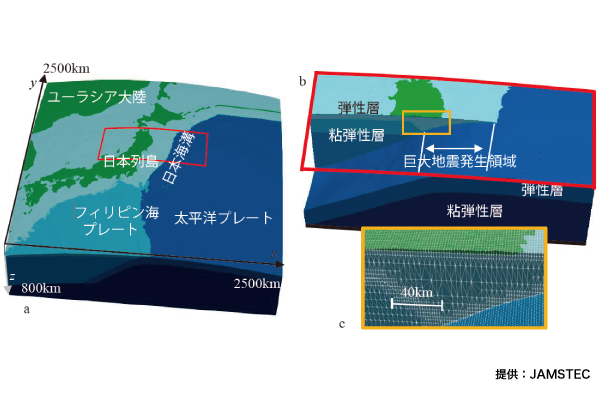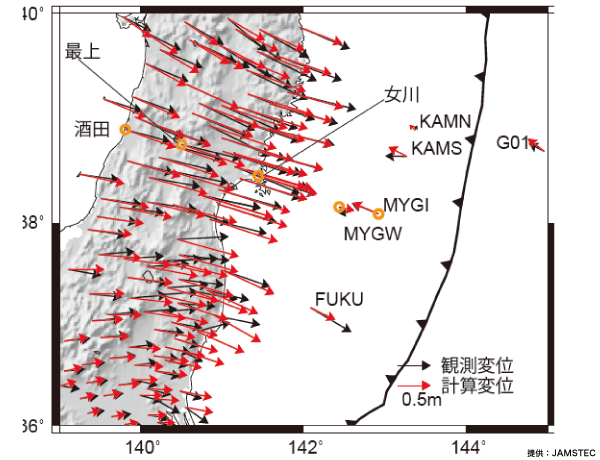- PROJECT MOTHER
- someone
- Information for Middle and High School Researchers
- Uncategorized
Movement of the earth's crust expressed by 350 million tetrahedrons
2021.03.14

Japan Agency for Marine-Earth Science and Technology
Research and Development Center for Earthquake and Tsunami Prediction
Earthquake Prediction Research Group
Ryoichiro Agata three
Mr. Agata of JAMSTEC is using the supercomputer "K computer" to reproduce the invisible earth beneath the Japanese archipelago in order to elucidate the movements of the earth's crust that cause earthquakes and other phenomena.
Knowing the unseen movement of the earth
The Earth's surface is made up of a puzzle of hard bedrock called plates. Each of these plates moves in a different direction, so that everywhere one plate is trying to sink into the other. In this process, the hard, less sticky plate experiences a large force that tries to return it to its original shape. When the force reaches its limit, the subducting plate jumps up to return to its original shape with great vigor. This violent movement of the crust is called an earthquake.
The effects of the 2011 off the Pacific coast of Tohoku earthquake are still continuing in the form of "aftereffects" (i.e., after-effects). Yo-ko-variation is crustal movement that occurs after a major earthquake and does not cause shaking. The uplift and subsidence of the crust in coastal areas have a significant impact on our daily lives. Agata and his colleagues are using simulation technology to reproduce crustal movement based on the observed data of after-effects of the Tohoku-Pacific Ocean Earthquake to elucidate the causes of earthquakes.
Moving the virtual earth
Previous studies have suggested that the aftereffect variation is related to the fast movement of the mantle beneath the plate. However, how this occurs has not been clearly explained. In order to clarify the movement of the mantle, which could not be reproduced by conventional simple models, we decided to incorporate complex calculations that simulate the movement of each of the rocks that make up the earth's crust. To prove our idea, we needed elaborate modeling that focused on the movement of each individual rock," Agata said. Agata and his team decided to use 350 million tetrahedrons to represent the rocks that make up the area around the Japanese archipelago. Each tetrahedron was given a property based on the experimental rock flow law to create a virtual Japanese archipelago that was as close as possible to the actual one. We then attempted to reproduce the movement of the earth's crust by performing large-scale calculations using the supercomputer "K computer.
As a result, we succeeded in reproducing phenomena similar to the results of crustal deformation that had been observed previously. The results of this study show that it is necessary to consider a complex set of factors, including the properties of rocks, in order to reproduce earthquakes and other motions that are largely related to the Earth's interior.

▲︎ The Japanese archipelago reproduced by 350 million tetrahedrons using the supercomputer "K computer".

▲︎ Comparison of observed and calculated displacements for 2.8 years after the 2011 off the Pacific coast of Tohoku earthquake. Complex observed displacement distribution is well reproduced by calculation.
Rationally Imagine the Future, Feeding on the Past
Earthquakes and volcanic eruptions still occur in many parts of the world and have a great impact on our lives. Therefore, we need to formulate and clarify hypotheses about these phenomena using the limited information available and the research results of past researchers. Simulation technology is a world of accumulating calculations, and is sometimes impersonal. However, it is precisely because it is so inflexible that it sometimes produces results that are surprisingly close to actual phenomena. It is a very effective approach to understanding how the Earth works," says Agata. The model patterns the possible movements of the earth and represents all possibilities on the computer. Simulation models are a beacon created by mankind that can deepen our understanding of the Earth.
(Text by Yuzen Kodama)
